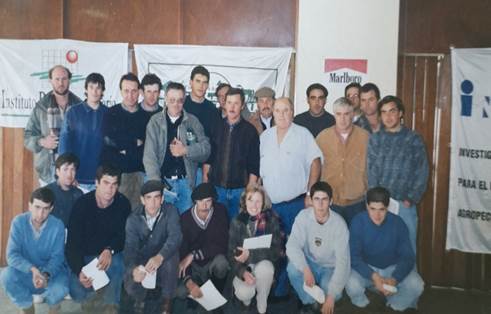The agronomist, master of science, Enrique Marchesi, also known as “El Quique”, passed away last Saturday 27th of February. He developed most of his professional career as an agricultural-livestock producer in partnership with other agronomists at the establishment “La Sorpresa” in the area of Cololó (Soriano). However, from his beginnings as a professor and researcher, Quique cultivated the passion for knowledge applied to proper soil management. This passion radiated across scientific institutions and farmer´s associations, with the result that these moved forward together. The following lines are dedicated to analyzing how and why Quique meant so much for our country's agronomy.
He started teaching in 1962 in the Department of Soil Science of the Agronomy College, University of the Republic. After his master's studies at Iowa State University, USA, he settled in 1969 as a Vegetal Production professor at EEMAC experimental station (Paysandú). In that year he also published Suelos del Uruguay (Uruguayan soils) (with Artigas Durán; volume 18 of the series Nuestra Tierra), a relatively brief work, but comprehensive and accessible to a general audience. He researched and trained students on issues related to soil and crop management. His students remember him as one of the best teachers, demanding and rigorous when discussing information, but also as “a peer in the classroom” (Eduardo Errea at the Council meeting on 1/3/21).
From 1972, he devoted himself to agricultural, livestock, and dairy production at the establishment “La Sorpresa”. He implemented the current principles of soil management and conservation, also integrating technological advances. Thus, he developed a production and conservation system based on contour grass strips (combined with “almost contour” but parallel grass strips), grassed waterways, alternating up or downhill throwing of furrows, rotation of crops and pastures, and management of stubbles. Due to the typical topography with variable slopes, some strips could not be parallel and these borders had to be “closed with stairs”. Reversible plows were an almost fundamental novelty for these tasks. Within a few years, the system of “drawn fields” became a technological reference in soil conservation to promote at the national level. The adoption of this system became a requirement on the part of the Bank of the Republic (BROU by its Spanish acronym) to access agricultural loans. For several generations of agronomists, marking contours and drains represented their first professional job. Quique maintained a good relationship with the teachers from the Department of Soil Science and the course had an annual field trip to La Sorpresa. Students of the 70s and first half of the 80s knew the educational vocation Quique had and could see the practical application of theory in the field.
By the end of the 80s, producers in the region were beginning to produce crops with no-tillage. Quique and other producers (pioneers of no-tillage agriculture in Uruguay) traveled to Argentina, Brazil, and Chile to learn about these experiences. Within that group, Quique helped to interpret the different “truths” that could be valid in other realities. In 1991, the Direct Sowing Uruguayan Association (AUSID by its Spanish acronym) was constituted formally, with Quique integrating its first board. As an AUSID referent, Quique actively promoted no-tillage production systems, adapting the technology to Uruguayan production conditions.
“Does no-tillage work? No, you have to make it work!”. In La Sorpresa, with the participation of several researchers from the Agronomy College and INIA, he installed one of the first long-term experiments in no-tillage. Stubble management was part of the treatments. It was necessary to demonstrate that no-tillage may not be successful without proper stubble management. “To plant directly is not the same as no-till planting”, he proclaimed. He always emphasized that “the objective is not to increase yields, neither to lower costs, but to avoid productivity losses over time as a result of soil erosion and loss of organic matter and associated functional properties”.
Quique was an outstanding integrator in agronomy. Impelled by the objectives of the AUSID, his speeches and conversations had basically two aims: to bring the problems of production closer to research or to integrate the advances of knowledge into production and conservation processes. Lines of work were carried out with experimental sites in fields of AUSID members, from the different specialties of the Agronomy College and INIA. Some areas were: disease management, weed control, soil plagues and beneficial organisms, fertilization and fallow length. Meanwhile, Quique continued teaching in no-tillage courses aimed at producers. In recognition of his contributions to national agronomy, he was distinguished with the “Tero de Oro” by the Association of Agronomists of Uruguay.
In conclusion, his life was developed with and for scientific knowledge in agronomy. Quique will have a special place in the personal memory of several generations of agronomists, producers, and scientists. In addition, Quique left his imprint in AUSID and, indirectly, in other institutions.
We say farewell with a long and heartfelt applause.

Figure 3: No-tillage course for farmers in 2000 (Cardona, Uruguay). Quique is wearing a short-sleeved shirt.


















